Halfback Saw???
What the hell is a halfback saw and why would I need one?
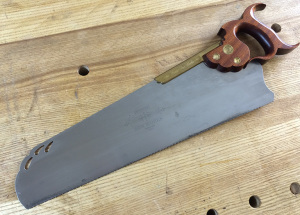 This is but one of the questions I usually get peppered with whenever I post this image in a social media channel. The half back is offensive and annoying to many who feel they have just figured out which saws they need in their nest only to have their world rocked with this hybrid abomination. It doesn’t fit nicely into their segregated world of back saws for joinery and backless saws for dimensioning.
This is but one of the questions I usually get peppered with whenever I post this image in a social media channel. The half back is offensive and annoying to many who feel they have just figured out which saws they need in their nest only to have their world rocked with this hybrid abomination. It doesn’t fit nicely into their segregated world of back saws for joinery and backless saws for dimensioning.
It was this odd ball nature that drew me to this saw. The fact that they were produced from 1860 until the 1920s tells me they weren’t some kind of fluke or gimmick (though production runs were low). Since I’m forever experimenting with old tools in the hopes of discovering a forgotten technique or process this saw seemed like a perfect opportunity. I believe there are only 2 modern makers of this saw, Wenzloff (not sure they are making it anymore) and Bontz, and the Disston originals are hard to find. I called my buddy Ron Bontz up since I was already swooning over his other saws and placed my order. That was more than a year ago and I think it is safe to call my experiment complete.
My intention isn’t to review specifically this Bontz saw, but rather focus on the type of saw and how it might find a use in your shop. But since I know the questions will come, let me reveal the specifics of this particular saw. From my research this is a pretty typical geometry for a half back saw.
- 18″ long
- 9 ppi
- Crosscut filed with 15° and 20° of fleam
Results may vary from one maker to another but let me be clear in that I don’t think that is something to worry about. While I love Ron’s saws, he isn’t sprinkling them with a special fairy dust that will make it perform any better than another saw with the same care and attention to detail put into it’s make. However, I do think Ron’s study of hang angles would give him a slight advantage in head to head tests depending on how you want to use your half back. (more on that later)
One Saw to Rule Them All
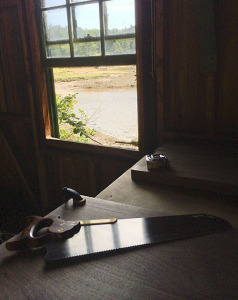 The easiest thing to say about this saw is it is like the Jack plane of saws. Or perhaps the Sham-Wow of saws. It slices, it dices, it watches the kids on date night. It is a viable contender in the single saw contest and I have been giving it a healthy work out. I built my treadle lathe almost entirely with this half back saw. Over the past summer I loaded this saw into my tool tote and took it with me to the Steppingstone Museum each weekend as well as any time I had work to do out of my shop. If you look closely at any of my videos in the last year you will find this saw featured prominently. In most cases it was the only saw I took with me. In August when I traveled up to Maine to build a trestle dining table, I took this saw and a carcass saw. Truly I could have left the carcass saw at home. Not only did I rip 10/4 Walnut with it, I cut massive tenons, bridle joints, and breadboard tenons.
The easiest thing to say about this saw is it is like the Jack plane of saws. Or perhaps the Sham-Wow of saws. It slices, it dices, it watches the kids on date night. It is a viable contender in the single saw contest and I have been giving it a healthy work out. I built my treadle lathe almost entirely with this half back saw. Over the past summer I loaded this saw into my tool tote and took it with me to the Steppingstone Museum each weekend as well as any time I had work to do out of my shop. If you look closely at any of my videos in the last year you will find this saw featured prominently. In most cases it was the only saw I took with me. In August when I traveled up to Maine to build a trestle dining table, I took this saw and a carcass saw. Truly I could have left the carcass saw at home. Not only did I rip 10/4 Walnut with it, I cut massive tenons, bridle joints, and breadboard tenons.
Let ‘er Rip
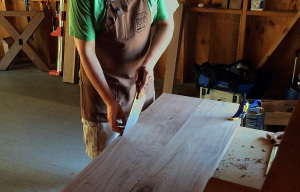 The saw didn’t flinch at any of these tasks and performed them admirably. If it faltered at all if was during ripping. Yes it was a bit tedious for the 7 foot rips in 10/4 Walnut but that is to be expected of any 9 ppi saw. The gullets are just too small to effectively clear the sawdust here so it is slow. It did however track a line perfectly and when I tipped it up almost vertically in the cut, it picked up speed substantially. My end result was a dead straight and plumb cut that was clean enough to only need 4 or 5 pass with the jointer plane to be ready for glue. Along a 7′ length that easily surpasses any results I ever got from my bandsaw. The size of this saw makes it a close competitor to the panel saws (20-24″ saws) in that it really excels in material already surfaced and in thicknesses under 1-1 1/4″. These panel saws are so named since they are employed to dimension a panel rather than break down rough stock like your typical “hand saw” (24″ and greater). So making long rips in thick stock is taking the half back out of its element. It performed well but not as efficient as I like to work. However when I used the saw “properly” for cutting 7/8 and 3/4″ thick boards to final length or panels to size it worked like a dream. The perfect combination of fast cutting and dead accurate, clean cuts.
The saw didn’t flinch at any of these tasks and performed them admirably. If it faltered at all if was during ripping. Yes it was a bit tedious for the 7 foot rips in 10/4 Walnut but that is to be expected of any 9 ppi saw. The gullets are just too small to effectively clear the sawdust here so it is slow. It did however track a line perfectly and when I tipped it up almost vertically in the cut, it picked up speed substantially. My end result was a dead straight and plumb cut that was clean enough to only need 4 or 5 pass with the jointer plane to be ready for glue. Along a 7′ length that easily surpasses any results I ever got from my bandsaw. The size of this saw makes it a close competitor to the panel saws (20-24″ saws) in that it really excels in material already surfaced and in thicknesses under 1-1 1/4″. These panel saws are so named since they are employed to dimension a panel rather than break down rough stock like your typical “hand saw” (24″ and greater). So making long rips in thick stock is taking the half back out of its element. It performed well but not as efficient as I like to work. However when I used the saw “properly” for cutting 7/8 and 3/4″ thick boards to final length or panels to size it worked like a dream. The perfect combination of fast cutting and dead accurate, clean cuts.
Cross Cuts
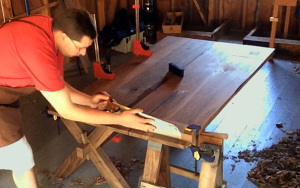 Where the half back really made a difference was with panels where a longer cross cut needed to be made. The 18″ plate quickly started a straight and square kerf over 12, 15, or 20″ panels without thought. Normally for longer cross cuts like this I would use my 14″ Sash saw or grab my 20″ panel saw. The half back was a happy combination of the stiff precision of my Sash and fast action of my Panel saw and now it is my go to any time I’m cross cutting something wider than about 8″ and need a close to finish cut.
Where the half back really made a difference was with panels where a longer cross cut needed to be made. The 18″ plate quickly started a straight and square kerf over 12, 15, or 20″ panels without thought. Normally for longer cross cuts like this I would use my 14″ Sash saw or grab my 20″ panel saw. The half back was a happy combination of the stiff precision of my Sash and fast action of my Panel saw and now it is my go to any time I’m cross cutting something wider than about 8″ and need a close to finish cut.
No where was this accuracy and efficiency with long cross cuts more apparent than cutting the shoulders of breadboard tenons on a 36″ wide dining table. I wanted this cut to be dead accurate not only across the top but also in depth. It is here where Ron’s chose of hang angle made such a difference. This particular saw likes to have a lot of teeth in the cut and it glides nicely when the tooth line is parallel to the surface. So making a cut to a precise depth across the entire 36″ surface was super simple and quick with this particular saw. Honestly I could see adding this saw to your kit for breadboards alone.
Joinery
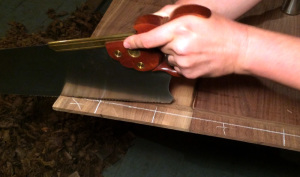 The real game changer was how it handled joinery, big joinery. With long tenons and deep half laps usually a tenon saw can start the cut but I would have to switch to a back less saw to take the kerf to my baselines. Even the biggest tenon and sash saws will bottom out around 3-4″. The half back has over 5″ of plate under the back up by the handle and the stiffness there is excellent for starting a cut but also it translates down the plate to make even the toe very stiff and responsive. I use this saw opposite of how I use my back saws in that I start the cut with the heel of the saw instead of the toe. Once my kerf is established then I switch to using the entire plate to quickly blow through the wood all the way to my baseline. If you are working with a joint that requires more depth than what is under the back then you truncate your stroke and use only the backless front part of the plate. In other instances, it wasn’t a necessarily big joint to be cut but something in a hard to reach area like the edges of my breadboard tenons that were set just far enough in from the edges that only a backless saw would reach to the line.
The real game changer was how it handled joinery, big joinery. With long tenons and deep half laps usually a tenon saw can start the cut but I would have to switch to a back less saw to take the kerf to my baselines. Even the biggest tenon and sash saws will bottom out around 3-4″. The half back has over 5″ of plate under the back up by the handle and the stiffness there is excellent for starting a cut but also it translates down the plate to make even the toe very stiff and responsive. I use this saw opposite of how I use my back saws in that I start the cut with the heel of the saw instead of the toe. Once my kerf is established then I switch to using the entire plate to quickly blow through the wood all the way to my baseline. If you are working with a joint that requires more depth than what is under the back then you truncate your stroke and use only the backless front part of the plate. In other instances, it wasn’t a necessarily big joint to be cut but something in a hard to reach area like the edges of my breadboard tenons that were set just far enough in from the edges that only a backless saw would reach to the line.
Now perhaps you just don’t cut a lot of big joints then the half back as a joinery saw might not make sense. This is just overkill for dovetails or typical tenons. I tried it anyway (I had too, its for science) and I ended up with great joints. But it is just silly to use such a big plate and aggressive pitch to cut fine joints like dovetails. Maybe it is just my choice of projects over the last year but I was surprised just how many times I ran across a joint that was too big for my regular nest of back saws. Angled joints in particular get real hairy and require plenty of depth beneath the back. Being able to rely on this saw over one of my panel saws made these joint go much easier.
The Ironing is Delicious
On the whole, while the half back appears specialized for big joints, the utility nature of a saw that can be used throughout a build, and the best in class performance on long cross cuts really makes this one of the most valuable saws in my nest. Ironically despite the odd, neanderthal nature of this saw, I think it would be most valuable in a power tool user’s shop. A shop where machines are used for rough work and a hand saw would never be considered. Those guys don’t have the hand and panel saws to fall back on when joints get big and oddly angled and their delicate joinery saws don’t have the capacity. Having a single saw in your shop that can handle any of these tasks is quite attractive to the power focused woodworker. Looking at it another way, the half back could be an excellent entry point for the woodworker looking to use hand saws more frequently. Rather than buying several specializes models, a single utility player is much more appropriate.
So I didn’t uncover any trade secrets from the last few centuries in my experiment, but I made a new friend that I can rely upon in my saw til. It doesn’t hurt that this particular saw is a pretty thing to look at either.


